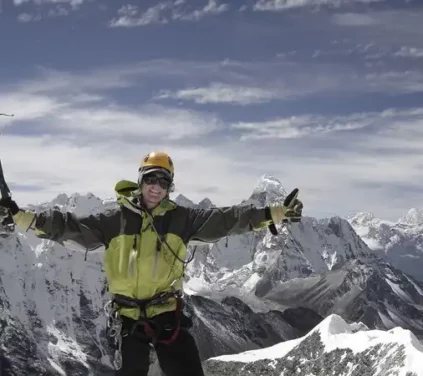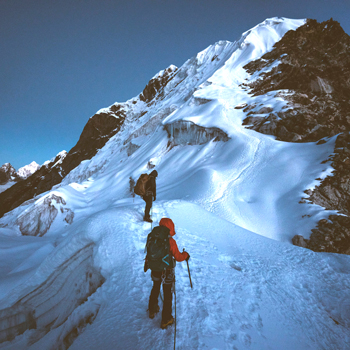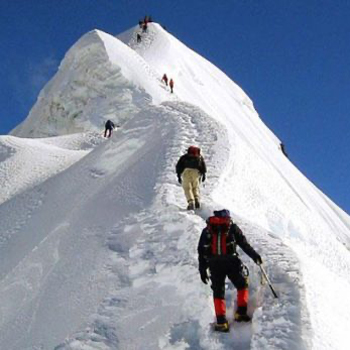Based on 9 reviews

Mera Peak Climbing
This Mera Peak climbing is popular among beginners
Duration
Meals
- 17 breakfast
- 16 Dinner
- 15 Lunch
Accommodation
- 3-nights hotel
- 14-nights eco-lodge
Activities
- Peak Climbing
- Trekking
- Sightseeing
SAVE
€ 480Price Starts From
€ 2400
Overview of Mera Peak Climbing
Mera Peak Climbing in the Mt. Everest region will be a once-in-a-lifetime encounter. Mera Peak, located in the south of Everest, possesses many natural characteristics that enchant you. Furthermore, the diverse valleys and woodlands will give you a thrilling mood. The frigid atmosphere, mountainous scenery, and Sherpa lifestyle will mesmerize you around Mera Peak.
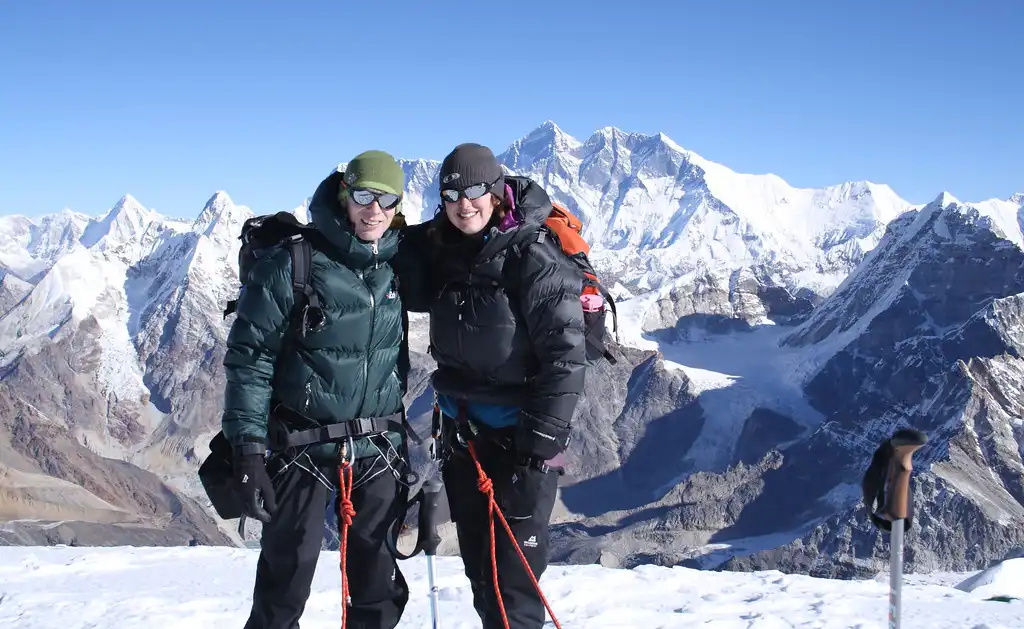
Mera Peak is the most popular and permitted trekking peak and lies south of Everest. The trail to the summit consists of two valleys, Hinku and Hongu Drangkas. We chose the best season and made the best Mera Peak Climbing itinerary. The heavily wooded and watershed valleys make the peak venturing to experience the amalgamation of snow, forests, and the valley. Nepal has showcased the pristine and serene beauty of nature.
Both the Hongu and Hinku valleys are remote and not habited land up to Kharka in the Upper Hinku basin, where Sherpa from the South, near Pangkongma, is the place for grazing animals during the rainy season. The upper Hongu Basin is mountain madness with massive moraines and glacial lakes, including Charming and Baruntse.
Mera Peak Climbing Highlights
- Summit Mera Peak (6476 Meters)– the highest trekking peak
- A stunning mountain view like Mount Everest Everest, Ama Dablam, Malaku, Kanchenjunga, Thamserku, and other peaks
- ShrepaCulture and lifestyle exploration
- UNESCO World Heritage Sites sightseeing
Mera Peak Climbing route
The trip to Mera Peak Climbing starts with a swashbuckling flight to Lukla, the tiny Himalayan town. The almost six-day trekking trail takes you through rhododendron forests, with oak, silver fir, and birch woods also highlights. These trekking activities help you acclimate before starting your peak climbing trip at Mera Peak.
The Mera Base Camp is located at the Mera Glacier. The Mera Peak crevasse is 5800m, while the first camp will be 3000m. The jaw-dropping views of Kanchenjunga, Makalu, Everest, Lhotse, Cho Oyu, and Ama Dablam treat you magnificently, assisting you in forgetting all the hardships during the climbing of the mountain.
Come and be a part of this fantastic trip to the Himalayas. Tell your memory tale about the heroism of Mera Peak Climbing. The Peregrine Team will help you fulfill your climbing dream.
Detail Itinerary of Mera Peak Climbing
Day 01: Arrival in Tribhuvan International Airport, Kathmandu
We complete our custom formalities at the Tribhuvan International Airport in Kathmandu. Afterward, a Peregrine Treks and Expedition representative will wait for us at the gate and take us to our hotel. We can then spend the rest of the day taking a rest. Overnight at a hotel in Kathmandu.
Meals: Not Included
Accommodation: The Everest Hotel
Day 02: Kathmandu: Mera Peak Climbing preparation and equipment checking
We rest for most of the day and unpack. Our climbing leaders will check our set of climbing equipment to ensure that they are in good condition for our next trip. We also got introduced to fellow participants and discussed our trip — overnight in Kathmandu.
Meals: Breakfast
Accommodation: The Everest Hotel
Day 03 Fly to Lukla, trek to Paiya (Chutok) (2,730m/8,956ft): 40 minutes flight, 5-6 hours trek
We catch an early morning flight to Lukla and begin our trek to Paiya after landing at the Tenzing-Hillary airport in Lukla. We walk on a jungle trail, cross a bridge over the Handi Khola and reach Surke Village. From here, we continue moving south and cross the Chutok La pass before reaching the small settlement of Paiyan, also known as Chutok. Overnight in Paiya.
Meals: Breakfast, Lunch, and Dinner
Accommodation: Teahouse
Day 04: Trek to Panggom (2,846m/9,337ft): 5-6 hours
We descend for a while and reach a small bridge. From here, the trail is slippery until we cross the Kari La Pass. We walk through rhododendrons and bamboo forests on a narrow mountain trail. We also get to be in awe of the Dudhkoshi Valley on today’s trip. We continue our trek to Panggom Village, whose settlers are dependent on farming and trading. Overnight in Panggom.
Meals: Breakfast, Lunch, and Dinner
Accommodation: Teahouse
Day 05: Trek to Ningsow (2,863m/9,393ft): 4-5 hours
We begin our trek after breakfast. After trekking out of Panggom, we cross the Panggom La pass. Then we ascend, walk on a steady path, and turn north. We cross Peseng Kharka Khola first, then after walking for some time, reach Peeng Kharka Danda. We cross Ningsow Khola (stream) before entering the Ningsow Village. Overnight in Ningsow.
Meals: Breakfast, Lunch, and Dinner
Accommodation: Teahouse
Day 06: Trek to Chhatra Khola (2,800m/9,186ft): 7-8 hours
From Ningsow, we climb first, then descend for a while and climb some more to reach Ramailo Danda. From here, we get extraordinary views of Mera Peak and Salpa. After ascending and descending our trail, we enter the Makalu Barun National Park.
Our trail from here to Chhatra Khola is called the Pasang Lhamu trail. On the way, if we are lucky, we might even come across the elusive Red Panda. Overnight in Chhatra Khola.
Meals: Breakfast, Lunch, and Dinner
Accommodation: Teahouse
Day 07: Trek to Kothe (3,691m/12,109ft): 6-7 hours
We walk towards the north on the main trail to Mera Peak. After walking on a trail next to the Majang Khola, we merge with another path that moves alongside the Hinku Khola. Our trail runs straight ahead towards Trashing Ongma, which has seasonal tea shops. We continue our trek and cross the bridge over the Sanu Khola before reaching Kothe. Overnight in Kothe.
Meals: Breakfast, Lunch, and Dinner
Accommodation: Teahouse
Day 08: Trek to Thaknak (4,358m/14,297ft): 3-4 hours
We trek along the ridge of the Hinku Khola in the shadow of Mera Peak. We take lunch at Gondishung, the summer herders’ settlement on the west bank of the Hinku Drangka.
Beyond Gondishung, we pass a 200-year-old Lungsumgba Gompa, where we can find Mera Peak scripted in rock along with its route to reach Mera. A short walk takes us to Thaknak, a summer grazing area with primitive lodges and shops. Overnight in Thaknak.
Meals: Breakfast, Lunch, and Dinner
Accommodation: Teahouse
Day 09: Trek to Khare (5,045m/16,486ft): 2-3 hours
Leaving Thaknak, we follow the lateral moraine of Dig Glacier to Dig Kharka, which offers spectacular views of Charpate Himal. The trail climbs through moraines to the snout of the Hinku Nup and Shar Glaciers and then climbs more steeply to Khare. From here, we can see the northern face of Mera Peak, which will be a fantastic experience. After lunch, we can hike in and around Khare. Overnight at Khare.
Meals: Breakfast, Lunch, and Dinner
Accommodation: Teahouse
Day 10 Khare: Acclimatization and pre-climb training
We have a particular day set aside solely for acclimatization and necessary training to prepare ourselves better for the Mera Peak climb. Our climbing leader will help us polish our basic techniques and demonstrate the best ways to use our climbing gears like the ice ax, harness, ascender climbing boots, and crampons. The training will also include learning the best climbing technique with the rope — overnight in Khare.
Meals: Breakfast, Lunch, and Dinner
Accommodation: Teahouse
Day 11: Khare to Mera High Camp (5,780m/18,958ft): 6-7 hours
We walk through a boulder-strewn course on a steep trail to reach the Mera Peak Base Camp. We continue further through the Mera La Pass to reach the Mera High Camp. Our path is along a rocky trail, which can be hazardous if it has recently snowed, as there are several crevasses here.
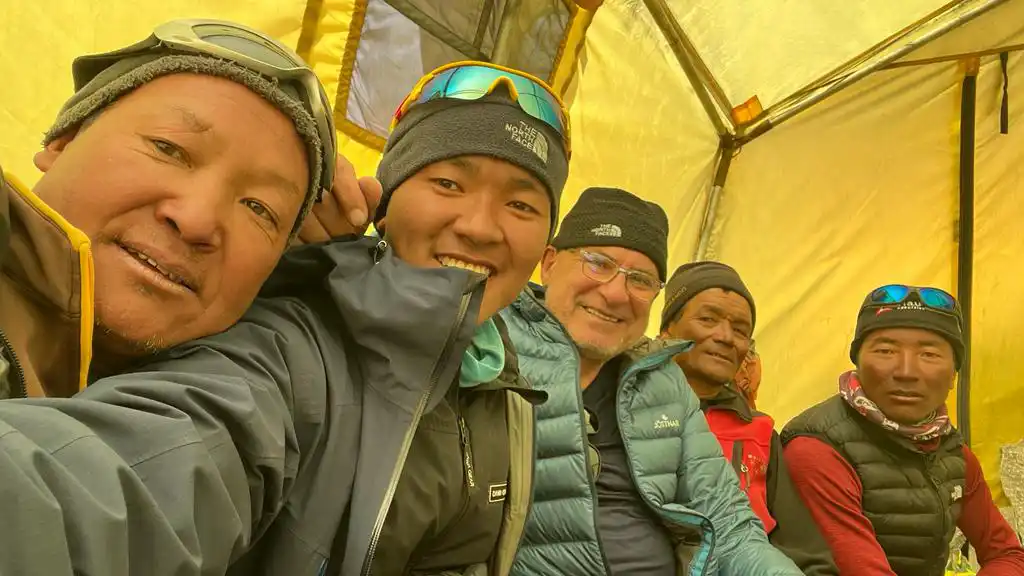
We make our way to the top of the rock band, marked by a large cairn. Then we set up a high camp while enjoying excellent views of Mt. Everest, Makalu, Cho Oyu, the south face of Lhotse, Nuptse, Chamlang, and Baruntse. Overnight at Mera High Camp.
Meals: Breakfast, Lunch, and Dinner
Accommodation: Tent
Day 12: Mera High Camp to Summit (6,461m/21,1907ft) and back to Khare (5045m/16,547ft): 8-9 hours
This is an important day for this Mera Peak Climbing. We wake up around 2 a.m. for breakfast. It’s going to be very cold initially, but soon we warm up as we continue up the glacier and onto a peculiar ridge.
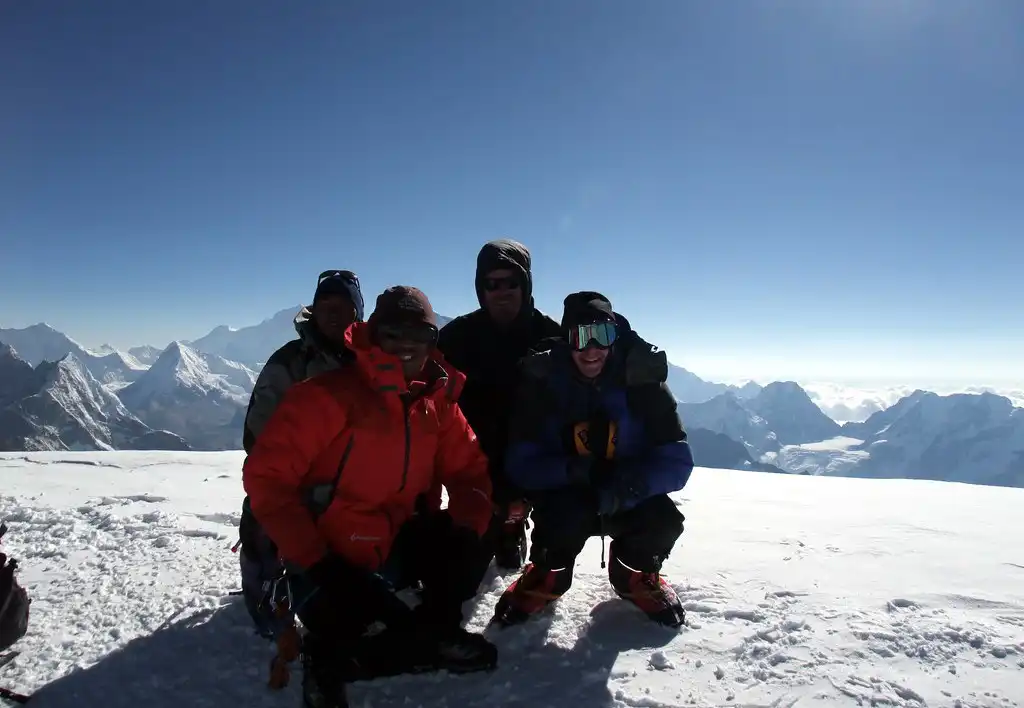
The first rays of the sun hit the prominent peaks in a striking red glow. The route is still non-technical as we slowly climb higher into the ever-thinning air. The slope steepens for a section behind the ridge, and the summit comes into view. We may use a fixed rope at the foot of the final steep summit cone if the climbing leader believes it’s required.

The summit is only a few meters away. From the summit, we take in spectacular views of the mighty Himalayas, including Mt. Everest (8,848m), Cho-Oyu (8,210m), Lhotse (8,516m), Makalu (8,463m), Kangchenjunga (8,586m), Nuptse (7,855m), Chamlang (7,319m), Baruntse (7,129m) and others. Later, we retrace our steps back to the high camp, where we rest for a while before descending to Khare. Overnight in Khare.
Meals: Breakfast, Lunch, and Dinner
Accommodation: Tent
Day 13: Reserve Day for Contingency for Mera Peak Climbing
There is no guarantee that we will have favorable weather on our planned day for the summit. Therefore, this day is a contingency if we cannot submit the Mera on the desired day due to adverse weather conditions or any other unanticipated reason. However, if the trip goes smoothly, this day will not be required.
Meals: Breakfast, Lunch, and Dinner
Accommodation: Tent
Day 14: Trek back to Kothe (3600m/11808ft): 4-5 hours
We trek from Khare to Kothe along the trail used before Mera Peak Climbing. After reaching Kothe, we celebrate our success by trying out local delicacies and wines. Overnight in Kothe.
Meals: Breakfast, Lunch, and Dinner
Accommodation: Teahouse
Day 15: Trek back to Thuli Kharka (4,300 m/14,107ft): 5-6 hours
We begin our trek to Thuli Kharka after breakfast. We climb up and descend and cross several tributaries of the Lnkhu Khola before reaching a forked trail near Taktho. We choose the path on our right and continue walking. Our trail passes by a Chorten, after which we walk downhill on a steep trail. Next, we ascend to Thuli Kharka and pass by another Chorten on the way. Overnight in Thuli Kharka.
Meals: Breakfast, Lunch, and Dinner
Accommodation: Teahouse
Day 16: Return back to Lukla via Zatrwa La pass: 6-7 hours
We cross the Zatrwa-La pass at 4,600. As soon as we cross the pass, we are welcomed by the sight of the beautiful Lukla Valley, which is surrounded by Cho Oyu, Kongde Peak, Numbur Himal, Kusum Kanguru, and other Himalayan peaks. From Zatrwa La Pass, we walk down to Chutang and then straight forward to the Lukla village. We enjoy dinner at Lukla in the evening with our Mera Peak Climbing crew member. Overnight in Lukla.
Meals: Breakfast, Lunch, and Dinner
Accommodation: Teahouse
Day 17: Fly back to Kathmandu
After successfully Mera Peak Climbing, We catch an early morning flight to Kathmandu. After reaching Kathmandu, we can take a rest or do some souvenir shopping. If we want to explore any other areas of Kathmandu, we may do that today.
Our guides can help you with both souvenir shopping and sightseeing. There will be a farewell dinner to celebrate the climbers’ successful summit of Mera Peak. Overnight in Kathmandu.
Meals: Breakfast, and Dinner
Accommodation: The Everest Hotel
Day 18: Farewell
Your adventure in Nepal comes to an end today! There is nothing to do but trade emails with your travel companions and organize your photos. A representative from Peregrine Treks will take you to the airport approximately 3 hours before your scheduled flight. On your way home, you’ll have plenty of time to plan your next adventure in the beautiful country of Nepal.
Meals: Breakfast
Customize this trip with help from our local travel specialist that matches your interests.
Includes & Excludes
What is included?
- Airport transfers in Kathmandu and guided sightseeing around the Kathmandu Valley, including entrance fees
- Accommodation at The Everest Hotel in Kathmandu, teahouse lodgings for trekking, and tented camps during the Mera Peak climb
- Three meals daily during the trek and Mera Peak expedition
- A skilled team of staff, including an experienced, English-speaking climbing guide, cook, assistant climbing leader (one per five trekkers), and Sherpa porters
- Domestic flight from Kathmandu to Lukla
- All essential permits, including trekking permits and Mera Peak Climbing permit
- High-quality mountaineering equipment for camping and Mera Peak ascents, such as North Face or Mountain Hardwear tents, mattresses, and kitchen supplies
- Travel and rescue support arrangements
- Farewell Dinner in Kathmandu
- Exclusive medical kit bag for the group
- All government and local taxes
What is excluded?
- Nepal visa fees and international airfare
- Excess baggage fees (if applicable)
- Extra accommodation and meals in Kathmandu due to early arrival, delayed departure, or early return from the Mera Peak climb
- Altitude chamber or supplemental oxygen (if needed)
- Travel and rescue insurance (mandatory)
- Personal climbing gear
- Private climbing guide upon request
- Personal expenses include phone calls, laundry, bar bills, bottled or boiled water, and showers.
- Tips for the trekking and climbing crew
Departure Dates
We also operate Private Trips.
Route Map
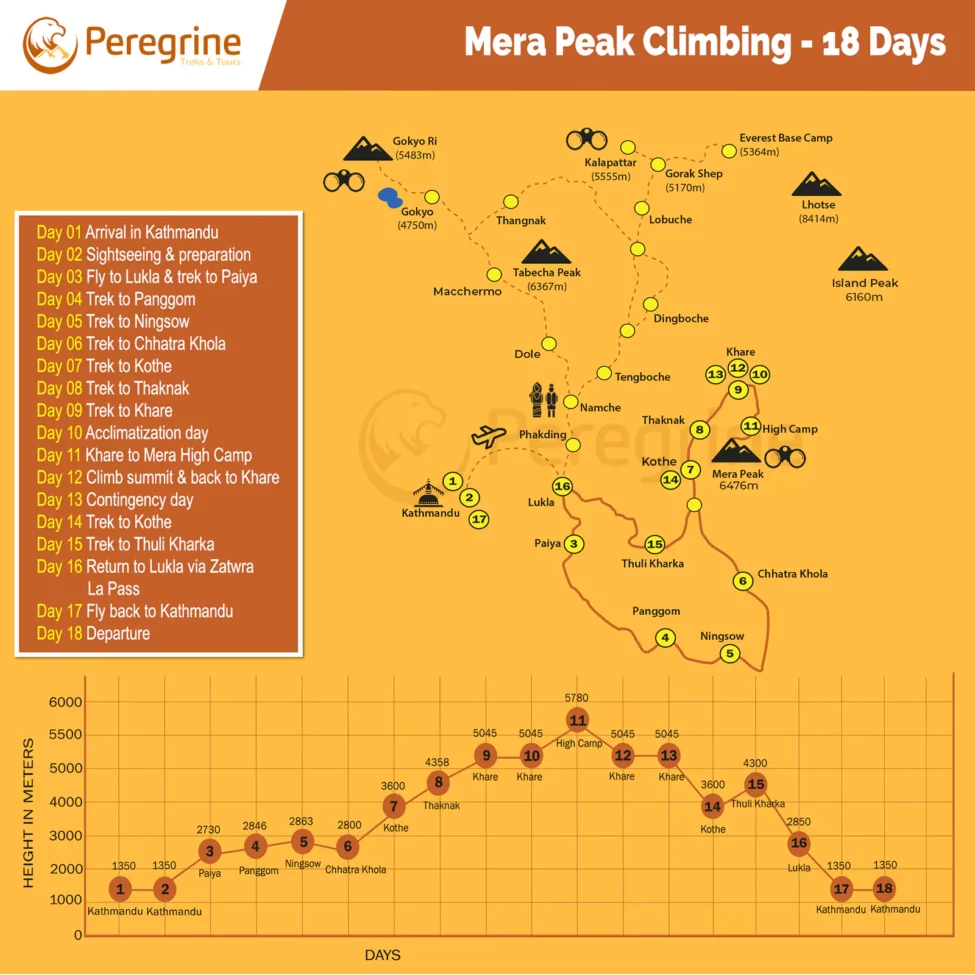
The adventure to Mera Peak Climbing begins with a plane from Kathmandu to Lukla. Then we’ll start our trek to Paiya (2730m), a northern trail with deep forest and steep hills. Similarly, we will rest and recoup in Paiya to save energy for the next day’s excursion. We will provide you with breakfast, dinner, and lunch as part of our package.
We will proceed to our next destination, “Pangan” (2846m), with magnificent morning freshness and a satisfying brunch (2846m). This will take about 5 to 6 hours to finish. This hamlet boasts its unique natural wonders. As you approach this village, you’ll sense the freshness and tranquility in the air. Various flowers and plants will be seen. As the program says, we’ll stay the night in Pangaun and have decent meals.
After breakfast, we’ll continue our trek to Ningsow (2863m) the following morning. On this day, the trekking trails will be persistent and rigorous. We’ll pass through Kharka Khola on our way to our destination. We’ll be able to enjoy the beautiful surroundings and dense forests that surround Kharka Dada. We will continue our journey after lunch at Kharka Dada. After a certain amount of time, we will arrive at Ningsow villages and spend the night.
Now things will get a little more exciting since we’ll be trekking through Makalu Barun National Park, where we’ll see a variety of flora and fauna. We’ll continue the north trial to the Chhatra Khola (2800m), passing through the Pashang Lamhu trial. Similarly, seeing endangered animals such as the red panda will be familiar. We’ll spend the night here and then trek a trail to Kothe (3681m).
It will take approximately 5 hours to get to Kothe. You will encounter various tea establishments if you approach Hinku Khola from the north. In either of those teahouses, we’ll enjoy snacks and lunch. As we continue our Climb, we will pass the river “Sanu Khola.” We’ll spend the night in Kothe after taking in the scenery. Breakfast, lunch, and supper are included in the package, just as on previous days.
After an excellent breakfast, we’ll trek to Thaknak (4258m). It would help to push yourself harder on this day because the elevation gain will be more significant. Moreover, we’ll stop at Gondishung for a fantastic traditional meal as we pass through Hinku Khola from the side. We shall pass by the 200-year-old Gumba if we take the left-north trail. We’ll arrive at Thaknak in the lap of Mera Peak after a few more hours of hiking. You will also appreciate your stay here if you decide to stay the night. This day also includes meals such as breakfast, lunch, and dinner.
Likewise, we’ll travel to Khare (5045m) across many glaciers the next day. We’ll eat lunch in a lovely teahouse in Khare. You will be awestruck by the scenery of stunning mountains and glaciers. We’ll spend the night at Khare, in the shadow of Mera Peak, before heading to Mera High Camp (6462m) the next day. We’ll climb to the summit of Mera Peak and camp for the night.
After admiring the spectacular Himalayan scenery and navigating the rugged terrain, we’ll also return to Khare. You’ll shoot Everest, Ama Dablam, and Kanchenjunga, among other peaks. After Kothe, we’ll gradually return to Pangaun before continuing to Lukla on the same trial. We’ll travel down to Kathmandu on a tiny Dornier jet from Lukla, ending our exciting Mera Peak Climbing.
Trip Information
Mera Peak Climbing Difficulties
In contrast to other peaks, climbing Mera Peak is relatively easy and moderate. It has little difficulty from north of Lukla, yet it is appropriate for both novice and expert climbers.
Weather and Temperature
Because of its geographic location, Nepal’s precipitation is nearly inconsistent. Climatic variations can almost undoubtedly inhibit the Mera Peak Climbing. Temperature and weather are less of an issue at lower elevations than higher altitudes. Because each season has its distinct weather pattern, climbing Mera Peak in the spring and fall is advisable. Average temperatures will range from 15 to 20 degrees Celsius during these two seasons, while nighttime temperatures will be below 2 degrees Celsius.
Similarly, the ascent would be more difficult during the monsoon season, from April to June. Furthermore, torrential rains and billowing clouds will blanket the whole mountain range. Due to the lack of vision, climbing will be difficult. The hills around Kothe will be pretty slippery. Similarly, it will be difficult during the cold months. Due to the massive snowfall and severely low temperatures, it will also be challenging throughout the winter season. As a result, adequate equipment and season-appropriate preparation will aid in overcoming this Mera Peak Climbing challenge.
Physical Fitness
The highest point on this climbing is Mera Peak. Climbing needs physical as well as mental stamina. Your body’s elasticity allows you to scale even the most challenging slopes rapidly. Before climbing, you should warm up and exercise. Fitness necessitates multi-body workouts that target all bodily components. Climbing will be more pleasant if you have reasonable respiratory control and a strong frame.
Similarly, psychological preparation before climbing will assist you in various ways. Consider ascending common slopes with light to heavy loads before trying Mera Peak Climbing. You’ll be able to carry your bag more quickly because of your powerful body. Climbing this beautiful peak without robust mental and physical health would be challenging.
Altitude Sickness
During our Mera Peak Climbing, we will reach a height of almost 5000 meters. At the highest heights, there is a considerable risk of altitude sickness. Rash, headaches, and uneasiness are all obvious signs that can be challenging. As a result, you’ll have to drink enough water to stay hydrated. Consuming meals and beverages that offer energy will be more helpful. In the same way, if you have altitude sickness, you should get help right away.
Distance and Duration
The overall distance covered by Mera Peak Climbing is roughly 80 to 85 miles. It will take 9 to 12 days to accomplish the Climb. The proximity will not be a hindrance for beginners. All you need to do before climbing is practice. Otherwise, you’ll fall behind the group. During the climbs, you’ll discover glaciers, waterfalls, and magnificent green trees. As a result, before attempting Mera Peak Climbing, you must prepare by training and working out.
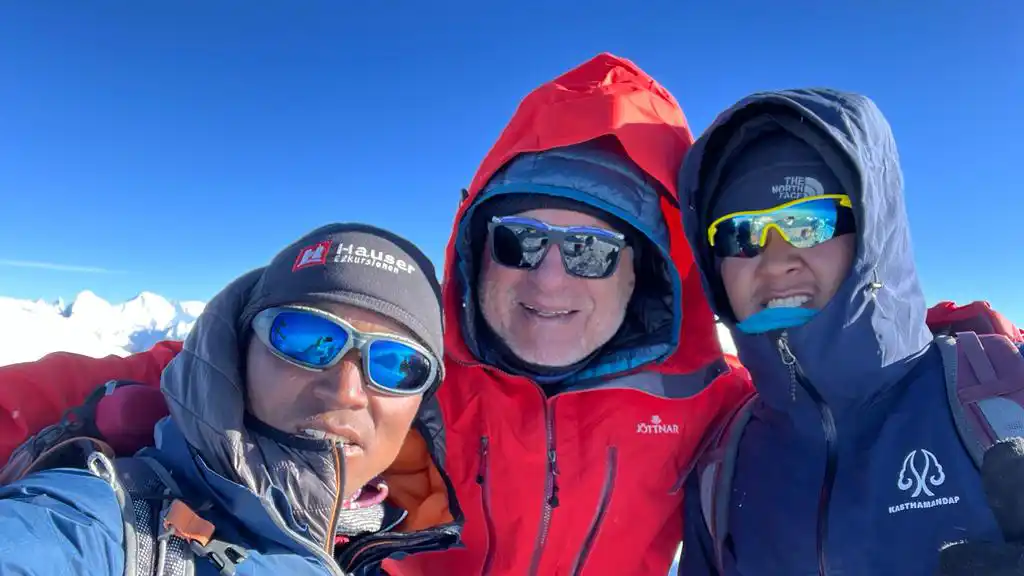
Mear Peak Climbing Routes
Different routes will guide you to Mera Peak. These are challenging and exciting routes. The first path leads directly to Mera Peak and is relatively simple to ascend. The peak is reached through the Zatra La Pass (4610m), passing through greenwoods and Sherpa villages. The second route is slightly longer and more demanding than the previous route. This route will take us past many villages and a national park to the peak.
Moreover, 2nd route includes Kothe, Kharka Dada, Hinku Khola, and Pangan. Climbers choose the third route, which is the most popular. Beginning from Namche Bazaar, this trail passes through most Sherpa communities. This route is a bit uphill, and there are a lot of barriers. To face steep slopes and treacherous hills, bring the appropriate equipment. This is also the longest of the routes. By taking this route, you will be able to understand the culture and traditional elements of the people who live in this region.
Best time for Mera Peak Climbing
You can ascend the Mera peak throughout the year. However, there are select times of the year when you may get the most out of your climbing.
Autumn Season
This three-month period of September, October, and November will provide the optimum opportunity for Mera Peak Climbing. These three months are all part of the autumn season. Similarly, this location obtains warm air this season, accompanied by many lovely flowers. The rhododendron-filled landscape will take your breath away. The temperature will be approximately 15 degrees Celsius during the day and 2 to 3 degrees Celsius at night. There will be very little rain this season, making climbing much simpler. Crowds may make teahouses and trials more challenging to navigate.
Spring Season
The spring season is defined by March, April, and May. You will see the magnificent view of several Himalayas throughout this season. Trekking will be much more beautiful with a clear view of massive mountains and gorgeous skies. Similarly, temperatures will range between 12 and 13 degrees Celsius during the day and below 0 degrees Celsius at night.
Moreover, the colorful flora and fauna contribute to the adventure. You’ll also need to bring shorts. Temperatures may rise higher than average during the day, which might be an issue. After the autumn season, this is the optimum time to climb Mera Peak.
Winter Season
December, January, and February are known as the winter months. During this time of year, there will be very few people. You will be allowed to visit every teahouse up to Mera Peak. However, flights and other products will be less expensive during this season. On the other hand, heavy snowfall and cold weather may make this season difficult. There won’t be any rain this season, either. During the day, the temperature will be around -15 degrees Celsius, while it will be around -10 degrees Celsius at night.
Monsoon Season (summer)
This is the season of June, July, and August. It would appeal to trekkers who enjoy adventure. It will be approximately 7 degrees Celsius at night, with temperatures reaching 20 degrees Celsius throughout the day. Mera Peak Climbing is fascinating due to the rain and mysterious clouds. There will be fewer people this season, and there is a good chance of receiving teahouse discounts. In addition, after the rain, you will get a beautiful view of the scenery and mountains.
Why Climb with Peregrine Treks?
For the past 30 years, we have been giving exceptional trekking excursions. Climbing with Peregrine Treks will become the most memorable experience of your life. You will cherish the moments you make with us for the rest of your life. First and foremost, your safety and security are essential to us. Before we begin climbing, we will inform you about our climbing location. Before the ascent starts, everything will be well-managed and adequately urged.
Our guides have received professional training and have a thorough understanding of everything. They are skilled communicators and can deal well with stressful situations. During your trek, these guides will then be your strength. Similarly, our services will satisfy you the most from the beginning to the finish of the climbing. To date, no one has ever complained about our services while climbing. Upon your arrival, we will place you in one of the top three-star hotels in Kathmandu. Similarly, the teahouses we recommend will please you on your Climb.
After visiting Nepal, you will have the incredible opportunity to climb with peregrine treks. While climbing, you may encounter a significant issue. Our experts will always be available to support you in your endeavor. The rescue squad will always be open to assist if anything transpires. Furthermore, when you leave Nepal, you will have a lot of priceless memories. Similarly, Peregrine Trek will be ahead in lodging, meals, and administering all relevant necessities. As a result, most climbers worldwide prefer to climb with Peregrine Trek.
Frequently Asked Questions
Kathmandu, the starting point for your Mera Peak Climbing adventure, is well-connected by air. Regular flights are accessible through major cities such as Bangkok, Doha, Hong Kong, Singapore, and Delhi.
Our Mera Peak Climbing packages include both an arrival and a departure day. You’re welcome to arrive earlier to explore Kathmandu if time permits. A representative from Peregrine Treks and Expedition will greet you at the airport. The first team briefing takes place on the evening of Day One. Please refrain from booking your return flight before the last day mentioned in the trip itinerary.
Yes, ‘E-tickets are now the norm. However, print your itinerary and keep your booking number handy. This information will assist our local agents in modifying your return flight if necessary, especially when you’re in the mountains.
We recommend waiting until the balance payment date for your Mera Peak Climbing to confirm that the trip has met the minimum participant numbers. If you find a good flight deal earlier, ensure your ticket is changeable to avoid potential loss in case of trip cancellation.
Arrive at Kathmandu International Airport (KTM), where a Peregrine Treks and Expedition representative will welcome you. Airport pickup is available even if you arrive before the official start date of your Mera Peak or Imja Tse Peak Climbing adventure.
Peregrine Treks and Expedition can arrange accommodations and offer sightseeing recommendations in Kathmandu. Please inform our office of your plans.
Indeed, a visa is necessary for the majority of nationalities. Upon arrival in Kathmandu or from a Nepal Embassy or consulate, you can obtain it. A 30-day visa costs $50, and a 90-day visa costs $120. Make sure to carry the required USD amount and a passport photo.
Most of our Mera Peak Climbing include oxygen as a medical backup. Additionally, we carry Personal Altitude Chambers (PACs). These chambers can quickly alleviate symptoms of altitude sickness, allowing the affected climber to descend to a lower altitude for recovery.
Our guides carry comprehensive medical kits, including medications specifically for altitude-related illnesses. If you have a history of altitude sickness, please consult your physician and us in advance. Otherwise, preventative medication is generally not required. Remember to bring any personal medications and a small first-aid kit.
You’ll carry a day pack weighing 5-10kgs (10-20lbs), containing essentials like warm clothes, water, snacks, and sunblock. On summit days, you’ll add heavier gear like your down jacket and technical climbing equipment.
The number of Sherpa guides varies depending on the group size and the specific Mera Peak or Imja Tse Peak Climbing you choose.
Our climbing attract a diverse group of climbers, from novices to experts, seeking anything from skill development to high-altitude challenges. We offer a range of courses, treks, and guided ascents to suit all levels of outdoor enthusiasts.
Absolutely. We’ve successfully organized private trips to various destinations, including 8,000m peaks and the Seven Summits. Private climbing offer increased flexibility and privacy, enabling you to ascend at your preferred pace.
Being in good physical shape is crucial for the success of your Mera Peak Climbing. Focus on endurance training and pack-carrying exercises, aiming to carry slightly more than your climbing pack weight. Incorporate long trekking days into your training regimen.
We grade our climbing by both physical exertion and the skill level required. This helps you find a climbing that matches your abilities and ambitions.
Comprehensive personal and medical insurance is mandatory for all our international expeditions, including those for climbing Mera Peak solo.
Yes, especially since many of our expeditions take place in remote areas. Immediate medical attention may be crucial in certain situations.
Once you book an expedition with us, we’ll provide detailed information on various insurance options suitable for your trip.
We strongly recommend purchasing trip cancellation insurance when you make your balance payment. This covers unforeseen circumstances that may force you to cancel your trip.
Reviews on Mera Peak Climbing
A perfect trip
I’ve got to say, me trip up to Mera Peak was bloody brilliant, all credit to the amazing team at Peregrine! I can’t speak highly enough of ’em, and I’m already buzzin’ to sort out me next Himalayan trek with Pradip and the lads. Honestly, every little detail was sorted with such attention and accuracy; it’s like they knew exactly what I was thinkin’! I reckon I’ve been so fortunate to have such a flawless journey, and it’s all down to the unreal crew at Peregrine. Cheers, mates!

Lily Wyatt
AustraliaBest Experience
I’ve got to tell you about my amazing journey to Mera Peak in October! I was part of a group set up by the awesome team at Peregrine, where I met four other fantastic trekkers. The whole expedition was masterfully organized by the owner, Pradip, who assembled a top-notch team of guides and porters to make sure we were safe while hiking over 6,000 meters above sea level. Every single person on the team went the extra mile to make sure we had the best experience ever. From the moment we left Kathmandu, everything was handled perfectly; we didn’t have a single thing to worry about!

William A. Wolf
United StatesMera Peak Climbing
When we made the decision to tackle Mera Peak in September 2016, we knew we needed a trustworthy, budget-friendly company that really knew the area inside and out. Peregrine checked all those boxes and then some! Right from our first interaction with them, they made us feel like part of the family. They answered all our questions with a level of patience and know-how that really put us at ease, ensuring we were totally ready for the climb. But what truly set them apart was their genuine warmth and friendliness. It felt like we were on an adventure with a bunch of long-time buddies rather than just another tour company. Dhanyabad!

Thomas B. Mejia
United States of AmericaAmazing Experience
Hey there, Pradip! It’s been a whole week since we got back home, and we’re still glowing from our amazing experience on our trip to Mera Peak. We’ve been looking through our photos and reminiscing about all the fun we had. We just wanted to reach out and say a huge thank you to you and your wonderful team. You guys really made our trip unforgettable! Thanks to Peregrine, we now have memories that will last a lifetime.

Grace Robertson
ScotlandIncredible Mera Peak
Blimey, what a remarkable journey to the summit of Mera Central! Massive kudos to Pradip and his splendid team of guides and porters – they turned the entire expedition into an absolute dream from beginning to end. I can’t commend them enough and am eagerly looking forward to my next climbing and exploring escapade with them. Cheers for everything, chaps!

Sofia Gregory
WalesUnforgettable experience
I just went on my second trip with Peregrine Treks, and it was totally awesome! I can’t even put into words how thankful I am for the amazing team that made my trek a complete win. They were super helpful and focused on service, plus the food was just out of this world. We all reached the summit, and I couldn’t be more thrilled! Huge thanks to Pradip for putting together this unforgettable adventure, and to the whole team for making it happen. You guys are the best!

James L. Castaneda
USAHIghly recommended trip
I went on Peregrine’s climbing tour to Mera Peak last October and November, and it was freaking epic. Everything was organized and professional, and they ensured we were safe and healthy throughout the trip. The views of the mountains were absolutely insane, and I legit felt like I had the adventure of a lifetime. I’d definitely recommend Peregrine if you’re looking for a dope trekking tour.

Loring Asselin
FranceMera Peak Climbing
As I stood atop the Mera peak summit, I couldn’t help but feel grateful for the support of my dear friend, the Peregrine. I might not have made it this far without their endless encouragement and unwavering faith in me. Thanks, Peregrine, you’re the best!

Élodie Lavoie
France